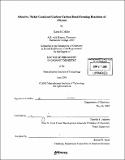Selective, nickel-catalyzed carbon-carbon bond-forming reactions of alkynes
Author(s)
Miller, Karen M. (Karen Marie)
DownloadFull printable version (13.75Mb)
Other Contributors
Massachusetts Institute of Technology. Dept. of Chemistry.
Advisor
Timothy F. Jamison.
Terms of use
Metadata
Show full item recordAbstract
Catalytic addition reactions to alkynes are among the most useful and efficient methods for preparing diverse types of substituted olefins. Controlling both regioselectivity and (EIZ)- selectivity in such transformations presents a significant challenge. In reactions that also involve the creation of a new stereocenter, the development of enantioselective processes is highly desirable. Several novel, nickel-catalyzed carbon-carbon bond-forming reactions of alkynes that display excellent regioselectivity and (E/Z)-selectivity are described. These reactions afford synthetically useful allylic and homoallylic alcohols, often with high enantioselectivity. A highly enantioselective method for the nickel-catalyzed reductive coupling of alkynes and aldehydes has been realized using the commercially available (+)- neomenthyldiphenylphosphine as a chiral ligand. Allylic alcohols are afforded with complete (E/Z)-selectivity, generally >95:5 regioselectivity, and in up to 96% ee. In conjuction with ozonolysis, this process is complementary to existing methods of enantioselective [alpha]-hydroxy ketone synthesis. In alkene-directed, nickel-catalyzed reductive couplings of 1,3-enynes with aldehydes and epoxides, the conjugated alkene dramatically enhances reactivity and uniformly directs regioselectivity, independent of the nature of the other alkyne substituent (aryl, alkyl (1°, 2°, 3°)) or the degree of alkene substitution (mono-, di-, tri-, and tetrasubstituted). The highly substituted 1,3-diene products are useful in organic synthesis and, in conjunction with a Rh-catalyzed, siteselective hydrogenation, afford allylic and homoallylic alcohols that previously could not be prepared in high regioselectivity (or at all) with related Ni-catalyzed alkyne coupling reactions. Enantiomerically enriched terminal epoxides can be employed to afford enantiomerically enriched homoallylic alcohols. P-chiral, monodentate ferrocenyl phosphine ligands are efficient promoters of catalytic, asymmetric reductive coupling reactions of 1,3-enynes with aromatic aldehydes and with ketones. The latter represents the first catalytic intermolecular reductive coupling of alkynes and ketones, asymmetric or otherwise, to be reported. Both of these methods afford chiral 1,3-dienes in excellent regioselectivity and modest enantioselectivity. Nickel-catalyzed reductive couplings of 1,6-enynes and aldehydes also display very high (>95 : 5) regioselectivity. Use of a monodentate phosphine as an additive leads to formation of the opposite regioisomer in equal and opposite selectivity (5: >95). These results provide strong evidence for an interaction between the remote alkene and the metal center during the regioselectivity-determining step.
Description
Thesis (Ph. D.)--Massachusetts Institute of Technology, Dept. of Chemistry, 2005. Vita. Includes bibliographical references.
Date issued
2005Department
Massachusetts Institute of Technology. Department of ChemistryPublisher
Massachusetts Institute of Technology
Keywords
Chemistry.